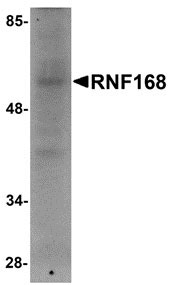RNF168 Antibody
- 产品详情
- 实验流程
- 背景知识
Application
| WB, E |
|---|---|
| Primary Accession | Q8IYW5 |
| Other Accession | NP_689830, 31377566 |
| Reactivity | Human, Mouse |
| Host | Rabbit |
| Clonality | Polyclonal |
| Isotype | IgG |
| Calculated MW | 65020 Da |
| Concentration (mg/ml) | 1 mg/mL |
| Conjugate | Unconjugated |
| Application Notes | RNF168 antibody can be used for detection of RNF168 by Western blot at 1 µg/mL. |
| Gene ID | 165918 |
|---|---|
| Other Names | E3 ubiquitin-protein ligase RNF168, hRNF168, 6.3.2.-, RING finger protein 168, RNF168 |
| Target/Specificity | RNF168; |
| Reconstitution & Storage | RNF168 antibody can be stored at 4℃ for three months and -20℃, stable for up to one year. As with all antibodies care should be taken to avoid repeated freeze thaw cycles. Antibodies should not be exposed to prolonged high temperatures. |
| Precautions | RNF168 Antibody is for research use only and not for use in diagnostic or therapeutic procedures. |
| Name | RNF168 {ECO:0000255|HAMAP-Rule:MF_03066} |
|---|---|
| Function | E3 ubiquitin-protein ligase required for accumulation of repair proteins to sites of DNA damage. Acts with UBE2N/UBC13 to amplify the RNF8-dependent histone ubiquitination. Recruited to sites of DNA damage at double-strand breaks (DSBs) by binding to ubiquitinated histone H2A and H2AX and amplifies the RNF8-dependent H2A ubiquitination, promoting the formation of 'Lys-63'-linked ubiquitin conjugates. This leads to concentrate ubiquitinated histones H2A and H2AX at DNA lesions to the threshold required for recruitment of TP53BP1 and BRCA1. Also recruited at DNA interstrand cross-links (ICLs) sites and promotes accumulation of 'Lys-63'-linked ubiquitination of histones H2A and H2AX, leading to recruitment of FAAP20/C1orf86 and Fanconi anemia (FA) complex, followed by interstrand cross-link repair. H2A ubiquitination also mediates the ATM-dependent transcriptional silencing at regions flanking DSBs in cis, a mechanism to avoid collision between transcription and repair intermediates. Also involved in class switch recombination in immune system, via its role in regulation of DSBs repair. Following DNA damage, promotes the ubiquitination and degradation of JMJD2A/KDM4A in collaboration with RNF8, leading to unmask H4K20me2 mark and promote the recruitment of TP53BP1 at DNA damage sites. Not able to initiate 'Lys-63'-linked ubiquitination in vitro; possibly due to partial occlusion of the UBE2N/UBC13-binding region. Catalyzes monoubiquitination of 'Lys-13' and 'Lys-15' of nucleosomal histone H2A (H2AK13Ub and H2AK15Ub, respectively). |
| Cellular Location | Nucleus {ECO:0000255|HAMAP-Rule:MF_03066, ECO:0000269|PubMed:19203578, ECO:0000269|PubMed:19203579, ECO:0000269|PubMed:19500350, ECO:0000269|PubMed:21041483, ECO:0000269|PubMed:22742833}. Note=Localizes to double-strand breaks (DSBs) sites of DNA damage. {ECO:0000255|HAMAP-Rule:MF_03066} |
For Research Use Only. Not For Use In Diagnostic Procedures.
Provided below are standard protocols that you may find useful for product applications.
BACKGROUND
RNF168 Antibody: RNF168 was identified as a chromatin-associated RING finger protein that acts as a ubiquitin ligase both in vitro and in vivo. RNF168 targets histones H2A and H2AX, but not H2B, forming K63 polyubiquitin chains. Upon formation of DNA double strand breaks, RNF168 is recruited to the site of DNA damage where it co-localizes with gammaH2AX and 53BP1 in an RNF8-dependent manner. This localization of RNF168 increases the local concentration of ubiquinated proteins to the threshold required for retention of the proteins 53BP1 and BRCA1, facilitating the downstream signaling cascade. Thus, RNF168 defines a new pathway demonstrating a functional cooperation between E3 ligases in genome maintenance. At least three isoforms of RNF168 are known to exist.
REFERENCES
Doil C, Mailand N, Bekker-Jensen S, et al. RNF168 binds and amplifies ubiquitin conjugates on damaged chromosomes to allow accumulation of repair proteins. Cell2009; 136:435-46.
Pinato S, Scandiuzzi C, Arnaudo N, et al. RNF168, a new RING finger, MIU-containing protein that modifies chromatin by ubiquitination of histones H2A and H2AX. BMC Mol Biol.2009; 10:55.
终于等到您。ABCEPTA(百远生物)抗体产品。
点击下方“我要评价 ”按钮提交您的反馈信息,您的反馈和评价是我们最宝贵的财富之一,
我们将在1-3个工作日内处理您的反馈信息。
如有疑问,联系:0512-88856768 tech-china@abcepta.com.























 癌症的基本特征包括细胞增殖、血管生成、迁移、凋亡逃避机制和细胞永生等。找到癌症发生过程中这些通路的关键标记物和对应的抗体用于检测至关重要。
癌症的基本特征包括细胞增殖、血管生成、迁移、凋亡逃避机制和细胞永生等。找到癌症发生过程中这些通路的关键标记物和对应的抗体用于检测至关重要。 为您推荐一个泛素化位点预测神器——泛素化分析工具,可以为您的蛋白的泛素化位点作出预测和评分。
为您推荐一个泛素化位点预测神器——泛素化分析工具,可以为您的蛋白的泛素化位点作出预测和评分。 细胞自噬受体图形绘图工具为你的蛋白的细胞受体结合位点作出预测和评分,识别结合到自噬通路中的蛋白是非常重要的,便于让我们理解自噬在正常生理、病理过程中的作用,如发育、细胞分化、神经退化性疾病、压力条件下、感染和癌症。
细胞自噬受体图形绘图工具为你的蛋白的细胞受体结合位点作出预测和评分,识别结合到自噬通路中的蛋白是非常重要的,便于让我们理解自噬在正常生理、病理过程中的作用,如发育、细胞分化、神经退化性疾病、压力条件下、感染和癌症。






